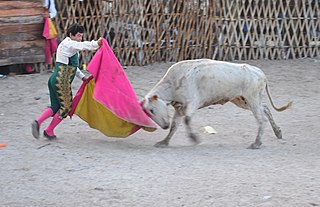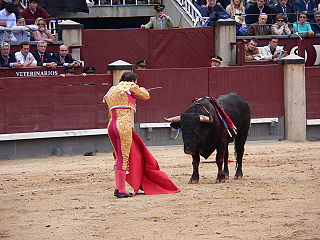
The Louisiana Purchase Exposition, informally known as the St. Louis World's Fair, was an international exposition held in St. Louis, Missouri, United States, from April 30 to December 1, 1904. Local, state, and federal funds totaling $15 million were used to finance the event. More than 60 countries and 43 of the then-45 American states maintained exhibition spaces at the fair, which was attended by nearly 19.7 million people.

A bullfighter is a performer in the activity of bullfighting. Torero or toureiro, both from Latin taurarius, are the Spanish and Portuguese words for bullfighter and describe all the performers in the activity of bullfighting as practised in Spain, Portugal, Mexico, Peru, France, Colombia, Ecuador, Venezuela and other countries influenced by Portuguese and Spanish culture. The main performer and leader of the entourage in a bullfight, and who finally kills the bull, is addressed as maestro (master), or with the formal title matador de toros. The other bullfighters in the entourage are called subalternos and their suits are embroidered in silver as opposed to the matador's gold. They include the picadores, rejoneadores, and banderilleros.

Forest Park is a public park in western St. Louis, Missouri. It is a prominent civic center and covers 1,326 acres (5.37 km2). Opened in 1876, more than a decade after its proposal, the park has hosted several significant events, including the Louisiana Purchase Exposition of 1904 and the 1904 Summer Olympics. Bounded by Washington University in St. Louis, Skinker Boulevard, Lindell Boulevard, Kingshighway Boulevard, and Oakland Avenue, it is known as the "Heart of St. Louis" and features a variety of attractions, including the St. Louis Zoo, the St. Louis Art Museum, the Missouri History Museum, and the St. Louis Science Center.

The Plaza de Toros de Las Ventas, known simply as Las Ventas, is the largest bullfighting ring in Spain, located in the Guindalera quarter of the Salamanca district of Madrid. It was inaugurated on June 17, 1931. Its seating capacity of 23,798, makes it the third-largest bullfighting run in the world, after bullrings in Mexico and Venezuela, respectively. After the federal ban of bulfighting in Plaza México, Las Ventas is the second largest bullring in the world still in operation for its original intention.

Leonidas Carstarphen Dyer was an American politician, reformer, civil rights activist, and military officer. A Republican, he served eleven terms in the U.S. Congress as a U.S. Representative from Missouri from 1911 to 1933. In 1898, enrolling in the U.S. Army as a private, Dyer served notably in the Spanish–American War; and was promoted to colonel at the war's end.

Alexander Monroe Dockery was an American physician and politician who served as the 30th governor of Missouri from 1901 to 1905. A Democrat, he was a member of the United States House of Representatives, representing the 3rd district from 1883 to 1899.

Concepción Cintrón Verrill, also known as Conchita Cintrón or La Diosa de Oro, was a Chile-born Peruvian torera, perhaps the most famous in the history of bullfighting. In the ring Cintrón was said to display particular grace, style and bravado, a combination known as duende.

The Campo Pequeno Bullring is the current Praça de Touros of the city of Lisbon, in Portugal. It is located in Avenida da República, in Lisbon.

El Fandi is statistically one of the most skilled matadors in the world. Currently, he is ranked number one among all bullfighters in Spain.

Spanish-style bullfighting is a type of bullfighting that is practiced in Spain, Mexico, Colombia, Ecuador, Venezuela, Peru, as well as in parts of southern France and Portugal. This style of bullfighting involves a physical contest with humans attempting to publicly subdue, immobilize, or kill a bull. The most common bull used is the Spanish Fighting Bull, a type of cattle native to the Iberian Peninsula. This style of bullfighting is seen to be both a sport and performance art. The red colour of the cape is a matter of tradition – bulls are color blind. They attack moving objects; the brightly-colored cape is used to mask blood stains.

Portuguese-style bullfighting differs in many aspects from Spanish-style bullfighting, most notably in the fact that the bull is not killed in front of an audience in the arena. The cavaleiros and the forcados are unique to the Portuguese variety of bullfighting, as well as the participation of horsewomen (cavaleiras) in the routines.

Patricia McCormick was an American bullfighter. She is thought to be the first woman in North America to fight bulls professionally.
There have been a few conspicuous instances of crime in the American city of Akron, Ohio. A rioting mob in 1900 destroyed several public buildings in their attempts to gain access to the suspect in a child sex attack. In the early 20th century a Black Hand gang led by Rosario Borgio ran an extortion racket; attempts by the police to suppress these activities led to the killing of several policemen and the execution of Borgio. Race riots broke out in 1968 when police were confronted by the inhabitants of the Wooster Avenue area.
The 1956 VFL Grand Final was an Australian rules football game contested between the Melbourne Football Club and Collingwood Football Club, held at the Melbourne Cricket Ground on 15 September 1956. It was the 59th annual Grand Final of the Victorian Football League, staged to determine the premiers for the 1956 VFL season. The match was won by Melbourne by 73 points, marking that club's eighth premiership victory.

Bullfighting is a physical contest that involves a bullfighter attempting to subdue, immobilize, or kill a bull, usually according to a set of rules, guidelines, or cultural expectations.

The lynching of Francis McIntosh was the killing of a free man of color, a boatman, by a white mob after he was arrested in St. Louis, Missouri, on April 28, 1836. He had fatally stabbed one policeman and injured a second.

Juan José Padilla is a Spanish torero ('bullfighter'). He became a matador de toros, 'killer of (full-grown) bulls', in the town of his birth, Jerez de la Frontera, on June 18, 1994 when he was 21 years old. He was known as the 'Cyclone of Jerez' and featured heavily, both personally and professionally, in Into The Arena: The World Of The Spanish Bullfight, a shortlisted nominee for the William Hill Sports Book of the Year in 2011.
Ernest Carleton Bass, best-known as Carleton Bass, born 1876 in Ireland, was a notorious bullfighter who billed himself in the late 19th and early 20th centuries as the "first North American bullfighter." In reality, he was an Irish immigrant who never became an American citizen, and his anemic bullfighting skill led to him being booed from bullfighting rings in Mexico. Though he had learned some swordfighting and bullfighting skills in Spain before his arrival in the United States, he was a poor fighter. In 1903, he suffered an attack of nerves before a fight in Mexico and failed to fight. In 1904, he was a key figure in the St. Louis bullfight riot, which led to the destruction of a 14,000-seat arena by fire. Three days after the riot, he shot and killed fellow matador Manuel Cervera Prieto after the other man attacked Bass with a knife over a dispute regarding the bullfight canceled by the riot. A subsequent coroner's inquest found Bass acted in self-defense and should not be charged with murder. Following his acquittal, Bass went on to star in several bloodless bullfights. These involved enraging the bull, causing it to charge and miss, but not spearing it or cutting it with a sword.

Bull wrestling, cow fighting or bull fighting is a non-lethal bloodsport between bulls or cows found in some parts of the world.

The Johnson–Jeffries riots refer to the dozens of race riots that occurred throughout the United States after African-American boxer Jack Johnson defeated white boxer James J. Jeffries in a boxing match termed the "Fight of the Century". Johnson became the first black World Heavyweight champion in 1908 which made him unpopular with the predominantly white audience of boxing. Jeffries, a former heavyweight champion came out of retirement to fight Johnson and was nicknamed the "Great White Hope". After Johnson defeated Jeffries on July 4, 1910, many white people felt humiliated and began attacking black people who were celebrating Johnson's victory.

















